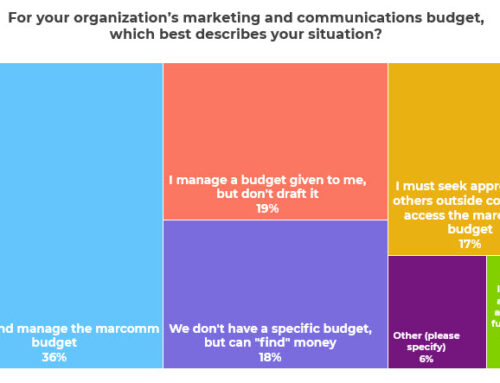
Community engagement is nonprofit communications professionals’ number one marketing and communications goal. Our Nonprofit Communications Trends Reports show that year after year.
But what does Community Engagement mean, and how can your nonprofit do it and measure it?
At Nonprofit Marketing Guide, we define “community engagement” as keeping people inspired by and active in our work.
But that’s still a rather broad definition. So we break it down even further by saying that community engagement includes Awareness, Interaction, and Participation. Depending on your stage, you’ll use different community engagement strategies and tactics and measure your success in different ways.
Awareness as Community Engagement
Awareness is about introducing your organization or issues to people for the first time. These are two different things.
Therefore, we often use the terms brand building and reputation management when discussing raising awareness of the organization. When talking about the substance of your work, we like to say you are raising issue awareness specifically.
Communications activities like search engine optimization, media relations, and list building are common awareness-raising and engagement activities. When raising awareness, you’ll often lean hard on your news writing and nonprofit storytelling skills.
Because it’s hard for nonprofits to know where to start, we offer a free e-course on How to Raise Awareness, where you can learn the basics of creating a successful plan to raise awareness of your issues.
The course includes
- The five steps to creating an awareness plan that actually works
- Understanding what “raising awareness” really means
- Putting awareness raising in the context of other goals, like fundraising or program participation
- Knowing and answering the most important questions for any awareness-raising campaign
- Our favorite calls to action for awareness campaigns
- How to apply social science research to your campaign so people will participate and remember
- Deciding which communications tactics to use
To measure your success in raising awareness, you must demonstrate that more people know who you are now than before. This can include metrics such as
- Growth in your email list
- Growth in your social media followers
- Growth in traffic to your website
- Activity on your website (e.g., downloads, form fills)
- PR/Media relations results
You can use these same measures, but with a bit more specificity, to measure issue awareness. For example, if you are trying to raise awareness about butterflies, is there more traffic going to your web pages about butterflies? Are more people clicking on your emails or seeing your social media posts about butterflies?
Interaction as Community Engagement
People know who you are or know about your issue because you raised their awareness. Now what?
Interaction is the next community engagement step to promote.
Interaction is about getting people to demonstrate that they are willing to move beyond being aware of you and your cause. Activities such as liking, commenting, and sharing on social media are forms of interaction that indicate engagement. Opening emails, clicking links, downloading documents, and other simple form completions on your website would also fall under interaction.
As you work on creating more interaction, you’ll lean harder on your nonprofit thought leadership, microcontent, and lifestyle writing skills.
Interaction is easy to track online — the hard part is figuring out exactly which interactions matter the most to you!
Participation as Community Engagement
Finally, participation is a form of engagement that requires following through on a call to action. It could result in learning more, advocating for your cause, or donating or volunteering. They are aware, they may be interacting, and now they are ready to fully engage and participate in some way.
Again, if you know your calls to action, then it’s fairly easy to track participation.
What’s the Right Mix for You?
As you think about what community engagement means for your nonprofit organization, give these three categories some thought . . . what is the right mix of awareness, interaction, and participation in your community engagement plan? Which results are most important? Which tactics will bring about those results?






